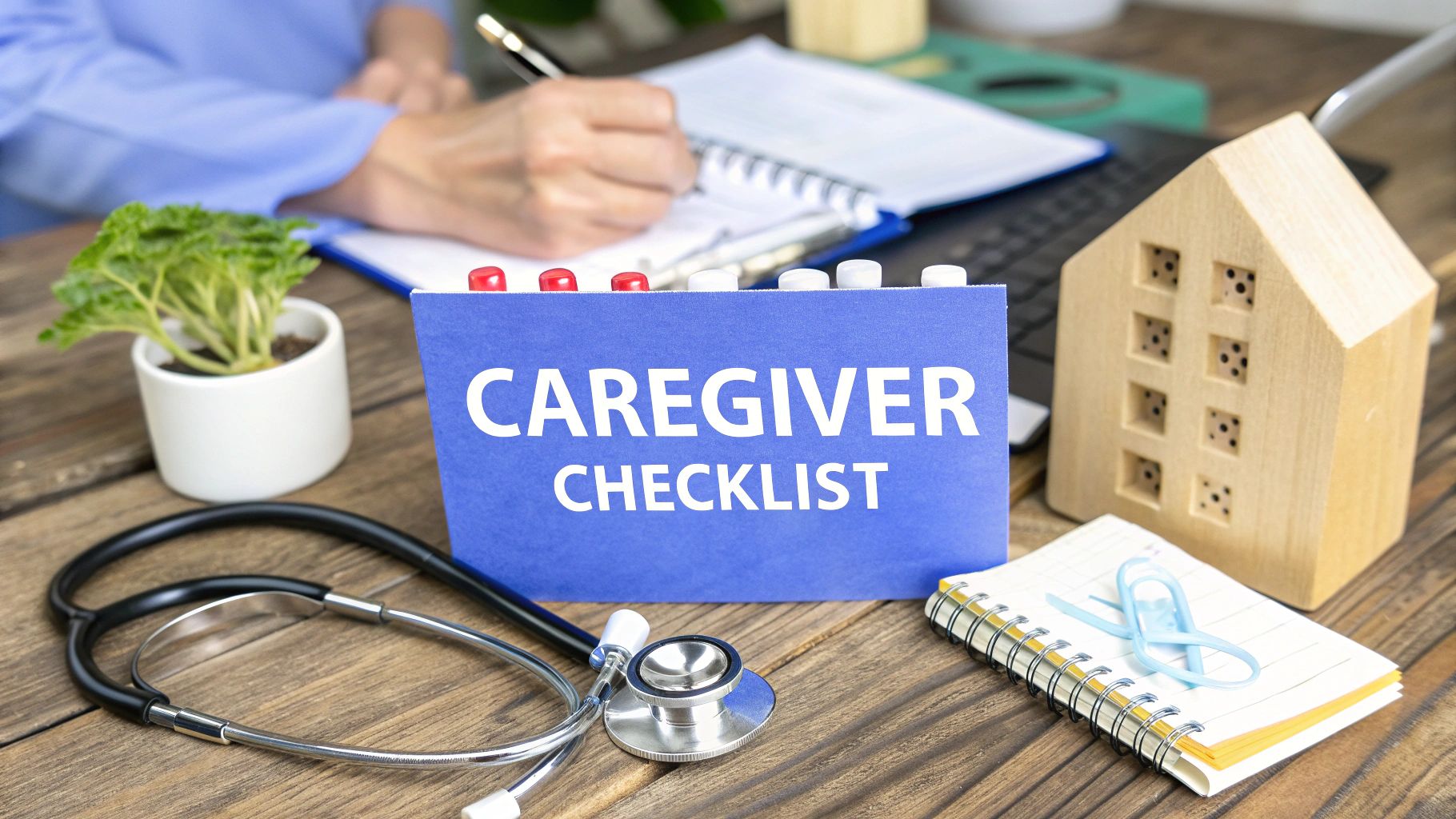Caregiving is a role built on a foundation of empathy, but its practice requires a robust set of tangible skills. Whether you are a professional, a family member stepping into a new role, or considering a career in care, understanding and developing these competencies is crucial for providing safe, effective, and dignified support. This is more than just a job description; it’s about mastering a diverse toolkit that ensures the well-being of another person.
This comprehensive caregiver skills checklist breaks down the 8 most critical areas every caregiver must master. We will move beyond the basics, offering a detailed framework to help you assess your current abilities, identify areas for growth, and build the confidence needed to handle the multifaceted demands of care. From technical procedures like medication management and health monitoring to the nuanced art of providing emotional support and advocating for a patient’s needs, this guide is your roadmap. Use this checklist to transform your compassionate intentions into capable, confident, and resilient caregiving actions.
1. Compassionate Communication
At the core of effective caregiving lies compassionate communication. This foundational skill goes beyond simple conversation; it's the ability to connect with empathy, patience, and understanding. It requires adapting your communication style to the care recipient's unique emotional state, cognitive abilities, and physical limitations. This crucial item tops any caregiver skills checklist because it directly impacts the quality of care, trust, and the emotional well-being of both the caregiver and the recipient.
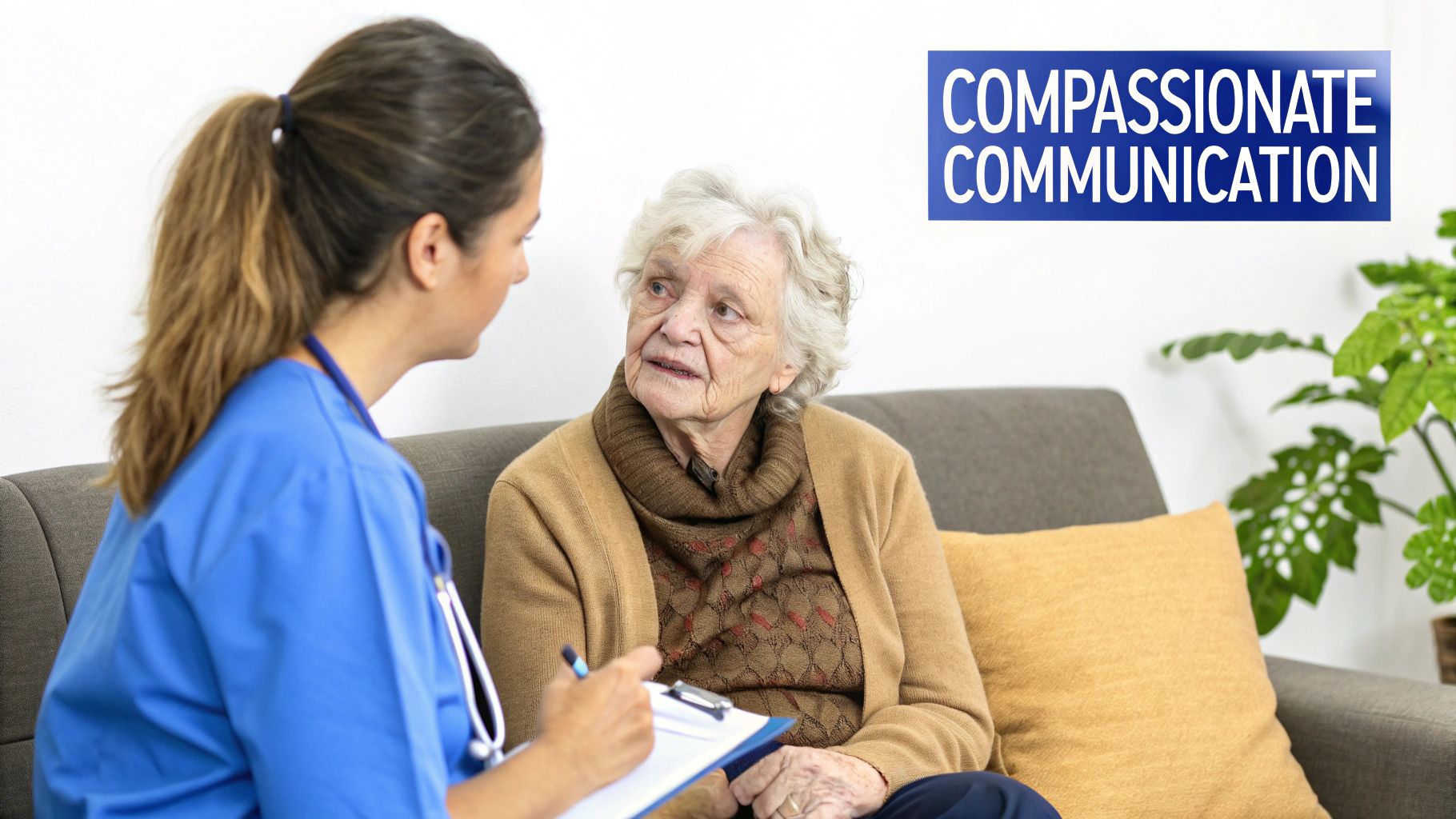
This approach, championed by experts like Teepa Snow and Dr. Naomi Feil, involves active listening, decoding non-verbal cues, and providing emotional support through both words and presence. It’s about meeting the person where they are, not where you expect them to be.
How to Implement Compassionate Communication
Successfully integrating this skill involves intentional practice. It’s about creating a safe space where the care recipient feels heard and valued, which is especially important when they are feeling vulnerable, confused, or frustrated.
- For Dementia Care: A caregiver might use a picture board with simple images of food, a drink, or a toilet to help a non-verbal individual express their needs. This visual aid bridges the communication gap caused by cognitive decline.
- For End-of-Life Care: A hospice worker uses therapeutic communication by sitting quietly with a patient, offering a comforting presence, and using phrases like, "It sounds like you're feeling scared. I'm here with you." This validates their feelings without offering false reassurances.
Actionable Tips for Daily Practice
Here are specific techniques you can start using today to enhance your compassionate communication skills:
- Maintain Eye Contact: Position yourself at the person's level. If they are in a wheelchair or bed, sit down so you can speak face-to-face.
- Simplify Your Language: Use short, clear sentences. Avoid complex questions and give the person ample time to process and respond.
- Practice Validation: Acknowledge their emotions. Instead of correcting a confused statement, you might say, "It sounds like you are worried about that," validating the feeling behind the words.
- Use Reflective Listening: Gently repeat back what you heard in your own words. For example, "So, you're feeling tired today and don't want to go for a walk. I understand." This confirms you are listening and helps prevent misunderstandings.
2. Personal Care Assistance
A cornerstone of any comprehensive caregiver skills checklist is the ability to provide personal care assistance. This involves the technical skills needed to help individuals with Activities of Daily Living (ADLs), such as bathing, dressing, grooming, and toileting. More than just a physical task, this skill requires a sensitive, dignity-preserving approach to some of the most intimate aspects of a person’s life. It is the practical application of care that ensures safety, hygiene, and comfort.
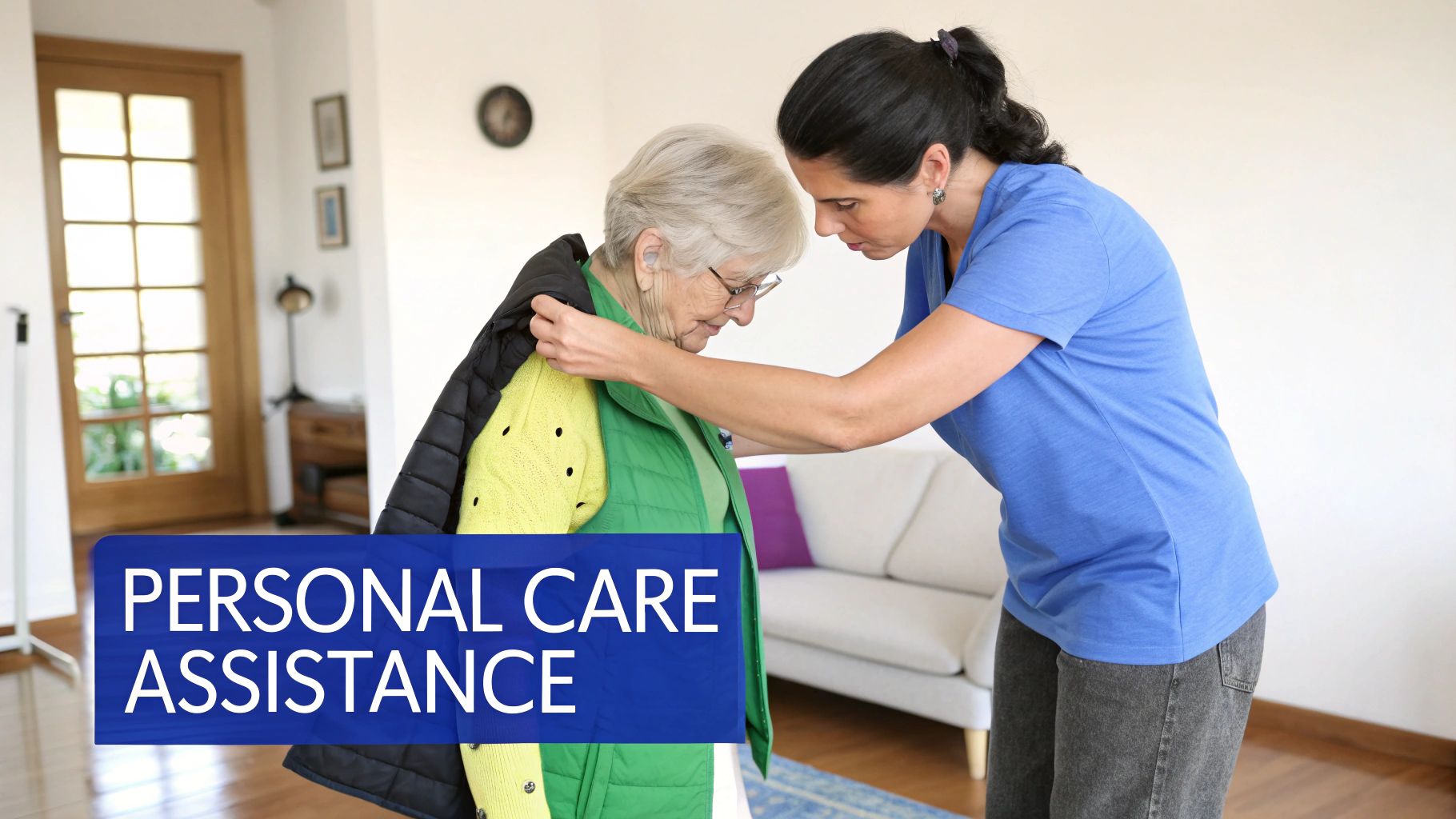
This hands-on support is a central focus in training programs from organizations like the Alzheimer's Association and the National Association for Home Care & Hospice. The goal is to perform these tasks competently while empowering the care recipient and protecting their sense of self-worth.
How to Implement Personal Care Assistance
Successfully providing personal care means combining proper technique with a person-centered mindset. This approach reduces the risk of injury for both the caregiver and recipient and transforms a potentially stressful routine into a respectful and collaborative process.
- In a Nursing Facility: A Certified Nursing Assistant (CNA) uses a Hoyer lift to safely transfer a resident with limited mobility from their bed to a wheelchair. This prevents strain on the caregiver’s back and ensures the resident is moved securely.
- In Home Care: A home health aide assists a client with showering by using a shower chair, grab bars, and a handheld shower head. This setup promotes safety and allows the client to participate in their own hygiene as much as possible.
Actionable Tips for Daily Practice
Here are specific techniques you can start using today to improve your personal care assistance skills:
- Always Explain First: Before you begin any task, clearly and simply explain what you are about to do. For example, say "I'm going to help you wash your back now."
- Prioritize Safety: Use proper lifting techniques by bending your knees and keeping your back straight. Always use assistive devices like gait belts or lifts when needed.
- Allow for Independence: Encourage the person to do as much as they can for themselves. This might mean laying out their clothes and letting them dress their upper body while you assist with their lower body.
- Establish a Routine: Consistency helps reduce anxiety, especially for individuals with dementia. Try to perform personal care tasks at the same time and in the same order each day.
3. Medication Management
Proper medication management is a non-negotiable component of any caregiver skills checklist, demanding precision, organization, and unwavering attention to detail. This skill involves the systematic process of administering medications correctly, monitoring for potential side effects, keeping meticulous records, and coordinating with healthcare professionals. Given that many care recipients manage multiple prescriptions, the risk of errors is high, making this a critical area of responsibility that directly impacts health outcomes and safety.

This systematic approach is championed by organizations like the Institute for Safe Medication Practices (ISMP) and has been streamlined by services such as PillPack (now Amazon Pharmacy). The goal is to create a foolproof system that eliminates guesswork and reduces the chance of dangerous mistakes, like missed doses or incorrect dosages.
How to Implement Medication Management
Successful implementation requires creating a structured and repeatable routine. This system ensures that the right medication is given to the right person, in the right dose, at the right time, and via the right route, which is essential for managing chronic conditions and preventing adverse drug events.
- For Seniors with Multiple Prescriptions: A family caregiver might use a pharmacy's pre-sorted blister pack service. Each bubble contains all the pills needed for a specific time of day, simplifying the process and minimizing the risk of confusion.
- For Tech-Savvy Families: A home care agency could use an electronic medication administration record (eMAR) system. This digital log tracks every dose given, sends reminders, and can be shared in real-time with family members and the care recipient's doctor.
Actionable Tips for Daily Practice
Here are specific techniques you can start using today to master medication management and ensure the safety of your care recipient:
- Use a Pill Organizer: A weekly or monthly pill box is a simple yet highly effective tool. Fill it at the beginning of the week to streamline daily administration.
- Maintain an Updated Medication List: Keep a comprehensive list that includes the drug name, dosage, frequency, prescribing doctor, and purpose. Bring this list to every medical appointment.
- Set Multiple Alarms: Use a smartphone, smart speaker, or simple alarm clock to create reminders for each medication time. This is especially helpful for medications that must be taken on a strict schedule.
- Conduct Regular Reviews: Schedule periodic medication reviews with a pharmacist or primary care physician to discuss all medications, including over-the-counter drugs and supplements, to check for potential interactions and discontinue unnecessary prescriptions.
4. Emergency Response and Safety
A critical component of any caregiver skills checklist is the ability to maintain a safe environment and respond effectively in a crisis. Emergency response and safety encompasses the proactive measures taken to prevent accidents and the reactive skills needed to handle medical emergencies. This includes everything from basic first aid and CPR to implementing fall prevention strategies and knowing precisely when and how to call for professional medical help. For families and individuals relying on care, this skill provides invaluable peace of mind.
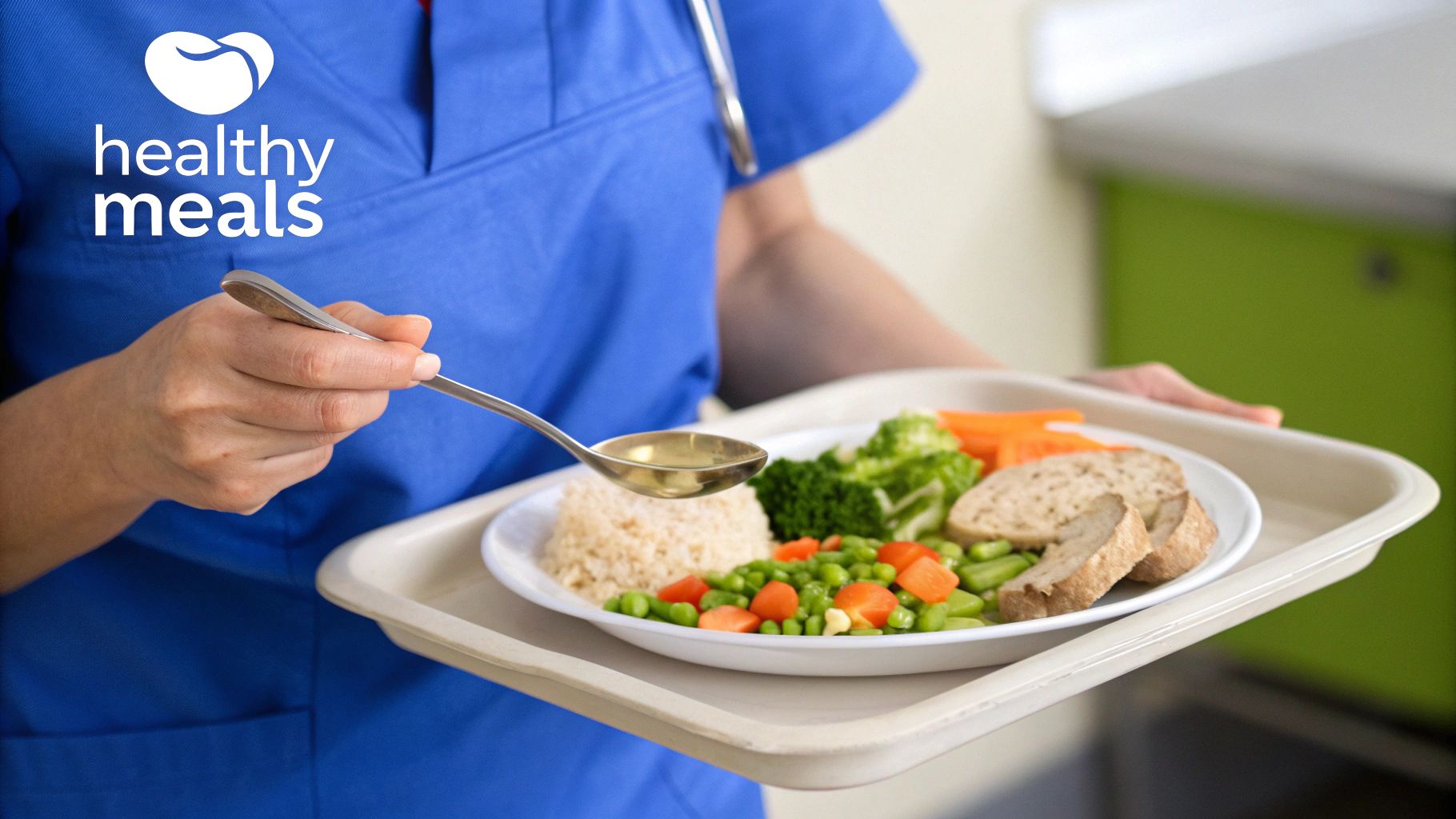
This focus on preparedness is heavily promoted by organizations like the American Red Cross and the National Safety Council. It involves a dual approach: minimizing risks in the home while simultaneously being equipped with the knowledge to act swiftly and calmly when an incident, such as a fall, sudden illness, or fire, occurs.
How to Implement Emergency Response and Safety
Successfully creating a safe environment requires a systematic approach to identifying and mitigating potential hazards. It is not a one-time task but an ongoing process of assessment and adaptation as the care recipient's condition changes.
- For Seniors Aging in Place: A family caregiver might install grab bars in the bathroom, secure loose rugs with double-sided tape, and ensure pathways are clear of clutter. They could also subscribe to a medical alert service like Life Alert to provide their loved one with immediate access to help.
- For Memory Care: A professional caregiver in a memory care facility may use a wander management system that alerts staff if a resident approaches an unsecured exit. They also conduct regular fire drills adapted for residents with cognitive impairments.
Actionable Tips for Daily Practice
Here are specific techniques you can start using today to improve your emergency response and safety skills:
- Create an Emergency Plan: Keep a clearly written list of emergency contacts, medical history, medications, and allergies in an accessible place, such as on the refrigerator.
- Conduct Regular Safety Sweeps: Once a week, walk through the home specifically looking for new hazards like poor lighting, frayed electrical cords, or unsteady furniture.
- Get Certified: Enroll in a basic first aid and CPR course through the American Red Cross or American Heart Association. Knowing how to use the contents of a first aid kit is essential.
- Practice Scenarios: If appropriate for the care recipient's cognitive level, talk through simple emergency plans. For example, discuss what to do if the smoke detector goes off or how to use a medical alert button.
5. Health Monitoring and Assessment
A critical responsibility for any caregiver is the ability to conduct health monitoring and assessment. This skill involves the systematic observation, tracking, and documentation of physical, cognitive, and emotional changes in the care recipient. It is a proactive approach to care that enables early detection of potential health issues, ensuring timely medical intervention and preventing complications. This item is a non-negotiable part of any caregiver skills checklist because it bridges the gap between daily care and professional healthcare.
This practice is heavily endorsed by leading health organizations like the Mayo Clinic and the American Nurses Association. It empowers caregivers to act as the first line of defense, recognizing subtle symptoms of illness or decline and communicating these vital observations effectively to healthcare professionals.
How to Implement Health Monitoring and Assessment
Successful implementation requires consistency and attention to detail. It's about establishing a baseline of the care recipient's normal state and then diligently watching for any deviations from that baseline. This vigilance can significantly improve health outcomes and provide peace of mind.
- For Chronic Disease Management: A family caregiver managing a parent's diabetes learns to use a glucometer, checks blood sugar levels at consistent times, and logs the readings along with food intake and activity levels. This detailed log helps the doctor adjust medication for better glucose control.
- For Post-Surgical Recovery: A home health aide monitors a client's surgical incision for signs of infection, such as redness, swelling, or drainage. They also track pain levels, vital signs, and mobility, reporting any concerning changes to the supervising nurse immediately.
Actionable Tips for Daily Practice
Here are specific techniques you can start using today to enhance your health monitoring and assessment skills:
- Establish Baseline Measurements: When the care recipient is stable, record their typical vital signs (blood pressure, heart rate, temperature, respiration rate), cognitive state, and mood. This baseline becomes your point of reference for future changes.
- Keep Detailed Logs: Use a notebook or app to document daily observations. Note any changes in appetite, sleep patterns, behavior, skin condition, or new symptoms like a cough or dizziness. Be specific with dates and times.
- Learn to Use Basic Equipment: Become proficient in using a blood pressure monitor, thermometer, and pulse oximeter. Ask a nurse or pharmacist to demonstrate proper technique to ensure accurate readings.
- Report Changes Promptly: Don't wait for a scheduled appointment to report a significant change. Clearly and concisely communicate your observations to the relevant healthcare provider. For example, say, "Dad's blood pressure has been consistently 20 points higher this week, and he's complaining of headaches."
6. Emotional Support and Mental Health Awareness
Providing physical care is only one facet of a caregiver's role; emotional support and mental health awareness are equally vital. This skill involves offering psychological comfort, recognizing the signs of mental health distress, and cultivating a supportive environment. It requires an understanding of the complex emotions tied to aging, illness, and dependency, including grief, anxiety, and depression. This element is a non-negotiable part of any caregiver skills checklist because it directly addresses the care recipient's holistic well-being.
This focus on psychological well-being is heavily promoted by organizations like the National Alliance on Mental Illness (NAMI) and the Alzheimer's Association. Experts like Teepa Snow also emphasize that addressing behavioral symptoms often means first addressing the underlying emotional or psychological need. It's about looking beyond the physical symptoms to care for the whole person.
How to Implement Emotional Support and Mental Health Awareness
Integrating this skill means being an emotional anchor for your care recipient. It involves creating a space where they feel safe to express their fears and frustrations without judgment, which is crucial for staving off feelings of isolation and hopelessness that can accompany chronic illness or aging.
- For Dementia Care: A family caregiver, noticing their loved one with Alzheimer's is becoming agitated, introduces music from their youth. This music therapy can soothe anxiety and spark positive memories, shifting the emotional state from distress to comfort.
- For Seniors Living Alone: A home care aide organizes regular visits from a pet therapy program. The interaction with a therapy animal provides companionship and unconditional affection, significantly reducing feelings of loneliness and improving mood.
Actionable Tips for Daily Practice
Here are specific techniques you can use to bolster your emotional support skills and promote mental wellness:
- Validate Feelings: Never dismiss their concerns as dramatic or irrational. Use phrases like, "It sounds like that was very frustrating for you," to show you are listening and that their feelings are legitimate.
- Encourage Social Connection: Actively facilitate safe social interactions, whether it's a video call with family, a visit from a friend, or participation in a community group. Meaningful activities fight isolation.
- Recognize Signs of Depression: Learn the common symptoms of depression in older adults, which can include loss of appetite, changes in sleep patterns, irritability, and apathy, not just sadness.
- Know When to Seek Help: Understand your limits. Be prepared to contact a primary care physician or a mental health professional if you notice persistent signs of severe depression, anxiety, or other mental health crises.
7. Care Coordination and Advocacy
Effective caregivers often act as the central command for a complex network of services. Care coordination and advocacy is the skill of managing multiple healthcare providers, services, and resources while fighting for the care recipient's best interests. It involves clear communication with doctors, insurance companies, social workers, and family members to ensure a seamless and comprehensive care plan. This vital skill belongs on any caregiver skills checklist because it prevents fragmented care and ensures the individual's needs are met and their voice is heard.
This skill is championed by professional organizations like the Aging Life Care Association and the National Association of Social Workers. It turns a caregiver into a project manager for health, ensuring all parties are aligned and working toward the same goals for the care recipient.
How to Implement Care Coordination and Advocacy
Successfully implementing this skill means becoming an organized, assertive, and well-informed representative for your loved one. It’s about building a unified front of support, especially when navigating complex medical systems or bureaucratic hurdles that can be overwhelming for someone who is ill or vulnerable.
- For Hospital Discharge: A family caregiver acts as a coordinator by meeting with the hospital discharge planner, asking about home health needs, arranging for necessary medical equipment, and ensuring follow-up appointments are scheduled before the patient leaves the hospital.
- For Chronic Illness Management: A geriatric care manager might create a shared digital calendar using a platform like CaringBridge. This allows family members, home health aides, and therapists to see the schedule for appointments, medication administration, and visits, preventing scheduling conflicts and keeping everyone informed.
Actionable Tips for Daily Practice
Here are specific techniques you can use to become a more effective care coordinator and advocate:
- Maintain a Master File: Keep a binder or digital folder with all medical records, contact information for providers, insurance details, and a log of communications. Bring this to every appointment.
- Prepare for Appointments: Before any medical visit, write down a list of questions and concerns. This ensures you cover all important points and make the most of the limited time with the provider.
- Understand Insurance Benefits: Regularly review insurance policies to understand what is covered, what requires pre-authorization, and what the out-of-pocket costs are. Don't be afraid to call the insurance company to clarify.
- Build Professional Relationships: Foster a positive, collaborative relationship with key healthcare providers, such as the primary care physician's nurse or the social worker. These connections can be invaluable when you need help or information quickly.
8. Nutrition and Meal Management
Proper nutrition and effective meal management are cornerstones of physical health for any care recipient. This skill involves more than just cooking; it’s the ability to plan and prepare appealing, nutritious meals that align with specific dietary restrictions, health conditions, swallowing difficulties, and personal preferences. As a crucial component of any caregiver skills checklist, mastering nutrition directly supports the recipient's energy levels, immune function, and overall well-being.
This vital skill is supported by organizations like the Academy of Nutrition and Dietetics and is a core focus of services like Meals on Wheels. It requires understanding the unique nutritional needs of aging adults or those with chronic illnesses and safely managing feeding assistance when necessary.
How to Implement Nutrition and Meal Management
Successful implementation means turning mealtimes from a chore into a positive and safe experience. This involves careful planning, safe food preparation techniques, and creating a pleasant dining atmosphere that encourages a healthy appetite.
- For Diabetic Patients: A caregiver consults with a registered dietitian to create a weekly meal plan that balances carbohydrates, proteins, and fats. They prepare portion-controlled meals and snacks to help manage blood sugar levels effectively throughout the day.
- For Individuals with Dysphagia: Following National Dysphagia Diet guidelines, a family caregiver learns to use a food processor to puree meats and vegetables to the correct texture, ensuring their loved one can swallow safely and avoid aspiration.
Actionable Tips for Daily Practice
Here are specific techniques you can use to improve your meal management and nutrition skills:
- Consult with Professionals: Work with a registered dietitian or a speech therapist to develop a safe and effective meal plan tailored to the recipient's specific medical needs, such as diabetes, heart disease, or swallowing issues.
- Make Mealtimes Social: Whenever possible, eat with the care recipient. A pleasant, unhurried social environment can improve appetite and make eating a more enjoyable part of the day.
- Keep Healthy Snacks Available: Have easy-to-eat, nutritious snacks like yogurt, cut fruit, or cheese sticks readily accessible to ensure consistent energy and nutrient intake between meals.
- Monitor Hydration: Actively track fluid intake and watch for signs of dehydration, such as dry mouth, dark urine, or confusion. Offer water, diluted juice, or broth frequently.
- Learn Safe Feeding Positions: If you provide feeding assistance, ensure the person is sitting upright (at a 90-degree angle if possible) during and for at least 30 minutes after meals to reduce the risk of choking or aspiration.
Caregiver Skills Comparison Matrix
| Skill/Service | Implementation Complexity 🔄 | Resource Requirements ⚡ | Expected Outcomes 📊 | Ideal Use Cases 💡 | Key Advantages ⭐ |
|---|---|---|---|---|---|
| Compassionate Communication | Moderate – requires ongoing emotional engagement | Moderate – time and caregiver emotional effort | High – improved trust, reduced anxiety | Emotional support, dementia care, hospice | Builds rapport, enhances compliance |
| Personal Care Assistance | High – technical physical skills needed | High – training, equipment, physical effort | High – preserves dignity, prevents complications | ADL support, mobility assistance | Supports independence, reduces stress |
| Medication Management | High – detail-oriented, systematic approach | Moderate to high – technology and training | Very High – prevents errors, improves outcomes | Complex medication regimens, aging in place | Enhances safety, reduces hospitalizations |
| Emergency Response and Safety | High – requires certification, regular updates | Moderate to high – training, equipment | Critical – can save lives, prevent injuries | Emergency preparedness, fall prevention | Life-saving, cost reduction |
| Health Monitoring and Assessment | Moderate to high – medical knowledge and tools | Moderate – medical equipment and training | High – early detection, better care planning | Chronic disease management, telehealth | Early problem detection, better coordination |
| Emotional Support and Mental Health Awareness | Moderate – requires emotional skills, boundaries | Moderate – time and training | High – improves quality of life, reduces isolation | Mental health support, behavioral changes | Prevents depression, strengthens relationships |
| Care Coordination and Advocacy | High – complex administrative and communication tasks | Moderate – organizational tools, knowledge | High – comprehensive care, fewer service gaps | Managing multiple providers, insurance navigation | Prevents gaps, maximizes resources |
| Nutrition and Meal Management | Moderate – dietary knowledge plus meal prep skills | Moderate – food resources, dietitian support | High – prevents malnutrition, manages conditions | Dietary restrictions, feeding assistance | Improves health, maintains cultural ties |
Integrating Your Skills for Holistic, Person-Centered Care
Moving through the items on this caregiver skills checklist is more than a simple exercise in ticking boxes. It's about recognizing that each skill, from compassionate communication to meticulous medication management, is an individual thread. The true art of exceptional caregiving lies in weaving these threads together into a seamless, supportive tapestry that envelops the person you care for in safety, dignity, and comfort.
Effective care is not compartmentalized. Personal care assistance becomes a prime opportunity for health monitoring and offering genuine emotional support. Nutrition and meal management directly impact the effectiveness of medications and overall physical well-being. Likewise, your ability to advocate for your loved one during a doctor's visit is strengthened by your detailed observations and understanding of their daily condition. This integrated approach transforms a series of tasks into a holistic, person-centered philosophy.
Key Takeaways: From Checklist to Confidence
Reflecting on the skills discussed, several core principles emerge as crucial for success and sustainability in a caregiving role:
- Adaptability is Essential: The needs of your loved one can change daily. The most effective caregivers are those who can adapt their approach, whether it means adjusting a meal plan based on new health information or finding a new way to communicate when words become difficult.
- Proactive, Not Reactive: Mastering skills like emergency preparedness and health monitoring allows you to anticipate potential issues before they escalate. This proactive stance reduces crises, minimizes stress, and creates a more stable environment for everyone.
- You Are a Vital Advocate: Your role extends beyond the home. You are the central coordinator and most important advocate, ensuring that the entire care team, from doctors to therapists, has a complete picture of your loved one's needs and preferences.
Your Actionable Next Steps on the Caregiving Journey
Building confidence with this caregiver skills checklist is an ongoing process of learning and refinement. It's a journey, not a destination.
Start by choosing one or two areas from the checklist where you feel least confident. Perhaps it's creating a more organized medication schedule or learning new recipes to improve nutrition. Seek out resources, watch tutorials, or connect with support groups to build your knowledge. Practice these skills with patience, both for yourself and for the person in your care. Remember, small, consistent improvements are more sustainable than trying to master everything at once.
Embracing this journey of skill development does more than just enhance the quality of life for the person you support. It empowers you, builds your resilience, and helps prevent caregiver burnout. By investing in your own capabilities, you are making a profound investment in the well-being of your loved one and fostering a more positive, rewarding, and manageable caregiving experience.
Whether you are a family caregiver in the Princeton area looking to enhance your abilities or are seeking professional support, understanding these skills is the first step. For expert guidance and compassionate, highly-trained in-home care professionals who embody this checklist, contact NJ Caregiving. Explore our services to see how we can support your family's unique journey at NJ Caregiving.

